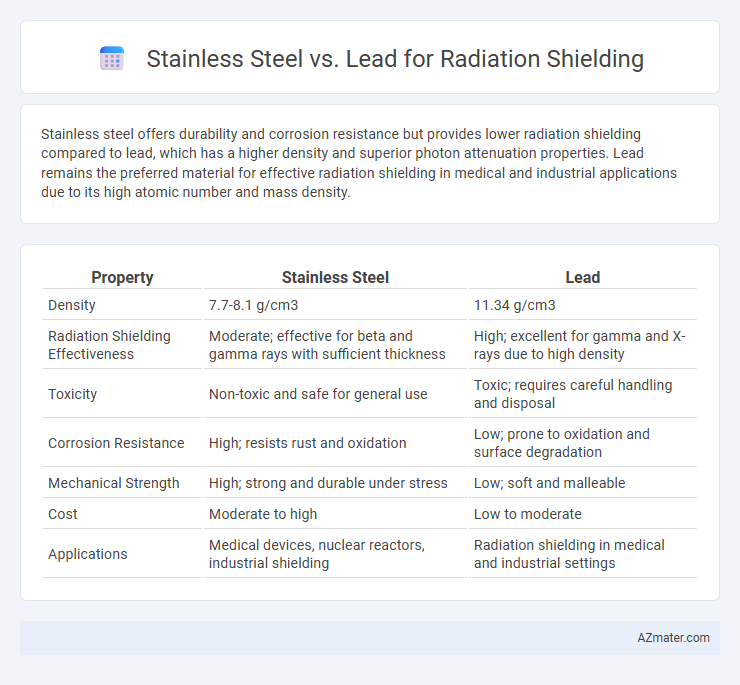Stainless steel offers durability and corrosion resistance but provides lower radiation shielding compared to lead, which has a higher density and superior photon attenuation properties. Lead remains the preferred material for effective radiation shielding in medical and industrial applications due to its high atomic number and mass density.
Table of Comparison
| Property | Stainless Steel | Lead |
|---|---|---|
| Density | 7.7-8.1 g/cm3 | 11.34 g/cm3 |
| Radiation Shielding Effectiveness | Moderate; effective for beta and gamma rays with sufficient thickness | High; excellent for gamma and X-rays due to high density |
| Toxicity | Non-toxic and safe for general use | Toxic; requires careful handling and disposal |
| Corrosion Resistance | High; resists rust and oxidation | Low; prone to oxidation and surface degradation |
| Mechanical Strength | High; strong and durable under stress | Low; soft and malleable |
| Cost | Moderate to high | Low to moderate |
| Applications | Medical devices, nuclear reactors, industrial shielding | Radiation shielding in medical and industrial settings |
Introduction to Radiation Shielding Materials
Radiation shielding materials are critical for protecting against harmful ionizing radiation, with stainless steel and lead being commonly used options. Lead offers high density and superior attenuation of gamma rays and X-rays, making it highly effective for radiation shielding. Stainless steel, while less dense, provides structural strength, corrosion resistance, and non-toxicity, making it suitable for applications requiring durability and safety.
Understanding the Importance of Radiation Protection
Stainless steel and lead serve crucial roles in radiation shielding due to their distinct physical properties and effectiveness in protecting against ionizing radiation. Stainless steel offers high structural strength and corrosion resistance, making it suitable for environments requiring mechanical durability alongside moderate radiation protection, while lead provides superior density and attenuation capabilities, effectively blocking gamma rays and X-rays. Understanding the specific radiation type, energy levels, and application context is essential for selecting the appropriate material to ensure optimal radiation protection and safety standards.
Properties of Stainless Steel for Radiation Shielding
Stainless steel offers excellent radiation shielding properties due to its high density, strong mechanical strength, and corrosion resistance, making it durable in harsh environments. Its composition, typically including iron, chromium, and nickel, provides effective attenuation of gamma rays and X-rays, while maintaining structural integrity under high temperatures. The material's versatility and ability to be fabricated into complex shapes enhance its suitability in medical, nuclear, and industrial radiation shielding applications.
Properties of Lead for Radiation Shielding
Lead exhibits high density and atomic number, making it exceptionally effective at attenuating gamma rays and X-rays in radiation shielding applications. Its malleability allows for easy fabrication into sheets, blocks, and custom shapes, enhancing its versatility in protective barriers. Lead also offers cost-effective shielding while providing superior protection against ionizing radiation compared to many alternative materials.
Shielding Effectiveness: Stainless Steel vs Lead
Lead exhibits superior radiation shielding effectiveness due to its high density (11.34 g/cm3) and atomic number (82), which enable it to attenuate gamma rays and X-rays more efficiently than stainless steel, which has a lower density around 8.0 g/cm3 and atomic numbers averaging between 24 and 30 depending on the alloy composition. Stainless steel provides moderate shielding, primarily effective against beta particles and low-energy photons, but requires greater thickness to achieve the same attenuation as lead. Cost, durability, and mechanical strength favor stainless steel in structural applications, though lead remains the preferred material for compact, high-efficiency radiation shielding.
Health and Environmental Risks: Lead vs Stainless Steel
Lead poses significant health risks due to its toxicity, causing neurological damage and environmental contamination through soil and water pollution. Stainless steel offers a safer alternative with no toxic emissions, reducing risks of heavy metal poisoning and ecological harm. Its corrosion resistance and recyclability further minimize environmental impact, making it an eco-friendly choice for radiation shielding.
Cost Comparison and Economic Considerations
Stainless steel offers moderate radiation shielding at a higher initial cost compared to lead, which is cheaper per unit weight but requires thicker barriers due to lower density. Economic considerations include long-term maintenance and disposal expenses where stainless steel's durability reduces replacement frequency and environmental handling costs. Choosing between them depends on balancing upfront investment against lifecycle savings and regulatory compliance for hazardous waste management.
Durability and Maintenance in Shielding Applications
Stainless steel offers superior durability compared to lead in radiation shielding due to its high resistance to corrosion, mechanical wear, and environmental degradation, ensuring long-term structural integrity in diverse settings. Lead, while effective at radiation attenuation, is softer and prone to deformation and surface oxidation, necessitating frequent maintenance to preserve its shielding effectiveness. The low maintenance requirements and robustness of stainless steel make it a preferred choice in applications demanding longevity and reduced operational costs.
Common Uses in Medical, Industrial, and Nuclear Fields
Stainless steel is widely used in radiation shielding for medical devices such as X-ray machines and linear accelerators due to its strength, corrosion resistance, and moderate density, providing effective protection from gamma and X-rays while maintaining structural integrity. Lead remains a preferred material in industrial radiography, nuclear power plants, and medical environments for shielding against high-energy gamma rays and X-rays because of its superior density and attenuation properties, offering compact and efficient barriers. In nuclear fields, stainless steel components serve in reactor containment and spent fuel storage where corrosion resistance and mechanical durability are critical, while lead is often employed in protective barriers and containers for radioactive materials to reduce exposure risk.
Future Trends in Radiation Shielding Materials
Emerging research in radiation shielding materials highlights the shift towards advanced stainless steel alloys with enhanced corrosion resistance and mechanical strength, outperforming traditional lead in structural applications. Innovations in nanotechnology and composite materials integrate stainless steel matrices with high-density elements, optimizing attenuation properties while reducing weight and environmental hazards associated with lead. Future trends emphasize sustainability, toxicity reduction, and improved durability, positioning stainless steel-based composites as the preferred solution in medical, nuclear, and aerospace radiation shielding.

Infographic: Stainless steel vs Lead for Radiation shielding
 azmater.com
azmater.com